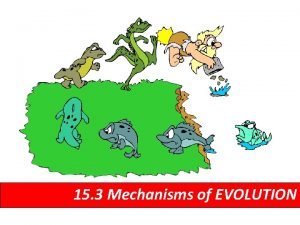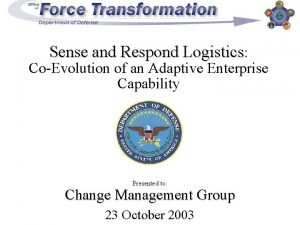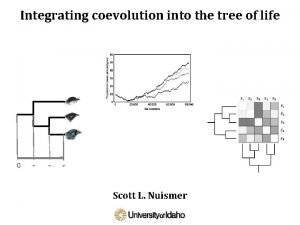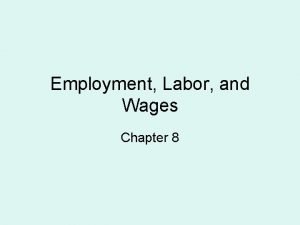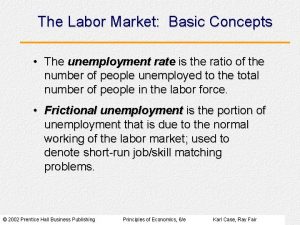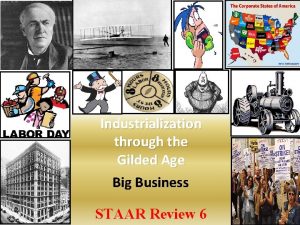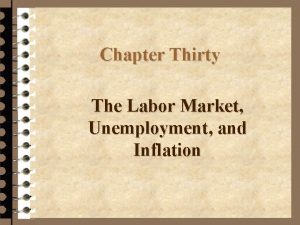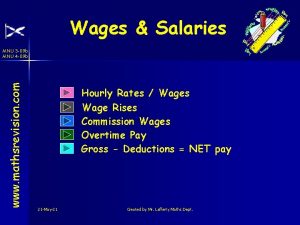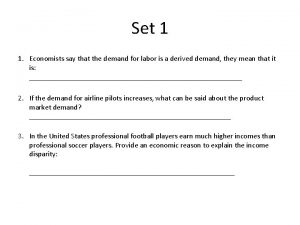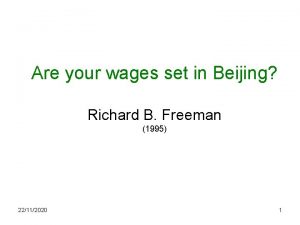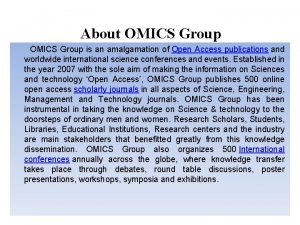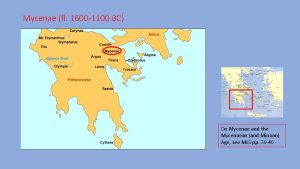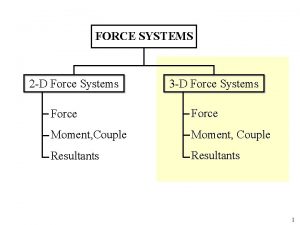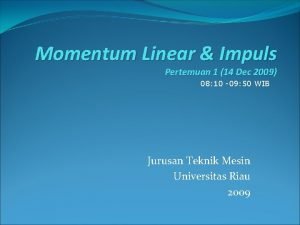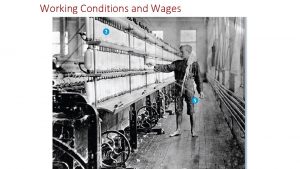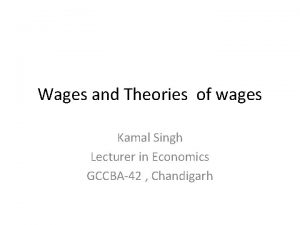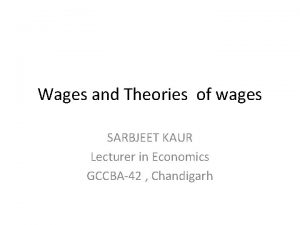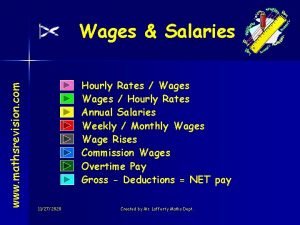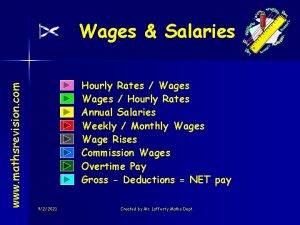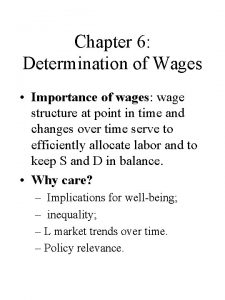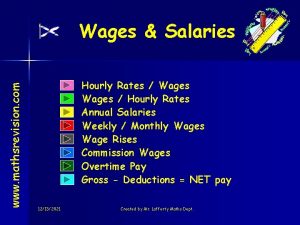The Coevolution of Technology and Wages 1600 2019

































































































- Slides: 97

The Co-evolution of Technology and Wages, 1600 -2019 Robert Allen Global Distinguished Professor of Economic History New York University Abu Dhabi Handbook for Historical Economics Conference New York University 2019

Four historical phases • • Early Modern Expansion (1600 -1770) Industrial Revolution (1770 -1867) Western ascent to affluence (1867 -1973) Problem-ridden present (1973 -2019)

Output per worker rose in all phases, but… • Early Modern Expansion (1600 -1770) – Average real wage rose, wage convergence • Industrial Revolution (1770 -1867) – Average real wage flat, wage divergence • Western ascent to affluence (1867 -1973) – Average real wage rose, wage convergence • Problem-ridden present (1973 -2019) – Average real wage flat, wage divergence

Questions: • Why did the periods differ? • How did evolution of technology affect wages? • How did wage changes affect evolution of technology? • How did globalization and scientific advance modulate the wage-technology interactions?

Phase I: European voyages of discovery led to colonies and empires • Spain and Portugal early winners • However, the best empires (from point of view of economic development) were Dutch and British • They contributed to large growth in manufacturing output, growth of cities and rural industries, agricultural & energy revolutions.

The industrial revolution was the result of 250 years of economic evolution.

In most pre-industrial societies, the real wage and the population are inversely related as in Italy

The inverse wage-population pattern is broken in England after 1600 due to its economic transformation.

Wages in Europe diverged before the IR

London and Amsterdam had (roughly) constant and high real wages:

While wages elsewhere dropped below one:

But England bucked that trend! (note wage convergence within England)

Factor price view: England was a high wage, cheap energy economy.

The growth of London led to the English coal industry, which gave northern Britain the cheapest energy in the world.

The high wage, cheap energy economy was caused by Britain’s foreign trade boom. • This began with wool cloth exports in the 17 th century and was consolidated by the creation of a world empire. • The trade boom pushed the urbanization rate from 7% in 1500 to 29% in 1800. • Rural manufacturing expanded, providing more jobs. • Tight labour markets meant high wages. • The growth of London from 50, 000 in 1500 to 1 million in 1800 caused the take-off of the coal industry.

Phase II: the Industrial Revolution: Why was the IR British? • The immediate cause was high wages and cheap energy. • They made it more profitable to substitute capital and energy for labour in England than elsewhere. • This made it more profitable to develop power driven machinery in England than elsewhere. • THEME: wages affect evolution of technology

Industrial Revolution was Britain’s creative response to the first globalization. • Started with Columbus (1492) and Vasco da Gama (1498). • By late 1600 s, large scale importation of Indian cotton textiles and Chinese porcelain • These were wildly popular • European industry tried to manufacture competitive substitutes.

To compete with Asian producers, British manufacturers had to cut labour costs. • Substituting capital for labour was the main approach. • Savings in labour costs had to be greater than increase in capital costs • Incentives to mechanize were greatest where wages were high • This favoured Britain.

Until about 1770, all fibres were spun in cottages, mainly on spinning wheels.

James Hargreaves invented the spinning jenny in the 1760 s, and it became the dominant technique into the 1780 s.

Richard Arkwright developed roller spinning (originally invented by Paul and Wyatt in 1740 s and 1750 s) in late 1760 s. It took off in 1780 s. Image Credit: Science Museum/SSPL

Cloth was woven by hand in cottages until early 19 th century.

Edmund Cartwright invented first power loom in 1785. More patents and a failed attempt at a factory in 1793. It only came into commercial use in early 19 th century.

Factor prices and induced technical change • Problems with production function representation of technical change – Factor augmenting TC is overgeneralized – Technical progress cuts costs at all factor prices • Technical change as new set of input-ouput coefficients – Diffusion of techniques

Example: cotton spinning C A P I T A L Isoquant for hand process K low wage cost line high wage cost line L Labour

Spinning jenny saved labour and was only cost effective in the high wage country (Britain) C A P I T A L Isoquant for machine Isoquant for hand process K* K low wage cost line high wage cost lines L* L Labour

Spinning jenny would have raised costs if it had been used in the low wage country (France or India) C A P I T A L Isoquant for machine Isoquant for hand process K* K low wage cost lines high wage cost line L* L Labour

Perfection of the jenny (i. e. mule spinning) makes mechanical spinning profitable everywhere. C A P I T A L Isoquant for machine Isoquant for hand process K* tipping point K low wage cost line trajectory of improvements high wage cost line L* L Labour

A key idea in analysing invention is the transition from R&D to commercial operation: R&D expense greater in low wage country C A P I T A L first proto-type Isoquant for machine Isoquant for hand process K* tipping point K low wage cost line trajectory of improvements high wage cost line L* L Labour

Spinning: 1500 -1770 • Wool industry very large, expands by producing ‘new draperies’. • Growth also in linen and after 1700 in cotton • Women spin all fibres and shift between industries to equalize earnings. • Huge expansion in spinning employment relative to female population. • Real earnings of women in spinning rise fast.

Expansion of wool spinning and employment Wool spun spinners % women 1500 14 mill lbs 152381 18 1590 35 225083 29 1615 48 338427 38 1640 44 342299 32 1700 57 495974 46 1750 71 651038 54 1770 86 785627 62

Earnings of female spinner relative to male building labourer


Rise in woman’s wage relative to cost of machinery raised rate of return. Profitability in France was much less.

Power Loom: Déjà Vu all over again Invention of spinning machines led to-- • Rapid expansion of output of low cost machine yarn • Weaving expanded to process yarn • Weaving was done by hand looms in cottages • Rise in employment (to 10% of male work force) led to high wages (rents) • High wages made invention of power loom profitable.

IR and the distribution of income • Who gained and who lost during the IR? • By how much? • How can we reconcile ‘high wage’ explanation with evidence of a big poverty problem during IR? • THEME: technology affects evolution of wages

Poverty was built into the Progress • Large handicraft manufacturing sector a key to high wage economy • Empire => exports of mfgs =>large sector=>high wages • Perhaps 1/3 of workforce in handicraft manufacturing • High wage=>mechanization=>falling wages in handicraft sector – That lowered average wage – Displaced workers moved into other handicraft sectors and put downward pressure on their wages

How did technical progress affect wages? For a long time only capitalists Phase I: Disconnect Between Productivity & wages Phase II: Productivity & wages grow in tandem

Wage inequality exploded as handicraft workers lost out

Phase III: Western Ascent to Affluence (1867 -1973) • The average real wage did not rise until the handicraft sector, which had been the basis of the high wage economy in the 18 th century, was liquidated. • Then wages grew in pace with output per worker. • Inequality declined.

Wages versus profits: British and USA experience British history American history

Why did the West get rich? by inventing labour saving technology. • High wages provide incentive to invent more mechanized technology. • More mechanized technology raised wages. • High (and growing) levels of education aided pure and applied research. • Over time Western technology became larger scale and more capital intensive. • Much of this technology is not cost effective in poor countries.

Today there is a ‘world production function’ that represents the technological options of all countries. Source: Kumar & Russell AER 2002 It shows diminishing returns to capital, limiting technology transfer.

1 st key feature: all change is due to rich countries inventing more capital intensive technology. All improvements are here! No Progress here

That’s my story of the Industrial Revolution. What happened in between? • I extended GDP, capital stock, and workforce backwards to 18 th century for 17 countries. • I looked at frontiers going back. • It’s biased technical change (with improvement only at high K/L ratios) all the way back! (déjà vu all over again!) • Improved methods only pay in high wage countries.

These countries were poor in 1800

















“The industrially advanced country presents to the less advanced country a picture of the latter’s figure” --Karl Marx

This has been the story since IR • Rich countries grew and created today’s technological possibilities. • After the rich countries abandoned a particular capital intensity, no other country has done anything to raise efficiency.

This is not Solow in action since there is no uniform percent increase in Q/L at each K/L GDP/ worker k/l

We continue to think of the incentives to mechanize with the same model as before: • New technology as new input-output coefficients • Did rising wages make new high K/L activities more profitable? • Answer is: YES

We can specify the problem better by distinguishing skilled from unskilled work • Some industries employed many unskilled labourers – In 1910 blast furnaces & steel works employed 194, 320 labourers out of 401, 039 employees • Other industries employed mainly skilled workers – Automobiles 15, 022 labourers out of 105, 758 • Different strategies required • Over time, in both cases, the skilled and unskilled were replaced by semi-skilled operators with routinized jobs

Unskilled wages were rising everywhere and were little higher in USA in Britain before 1920 1905 UK pence per day

Skilled wages were a lot higher and rising especially rapidly 1905 UK pence per day

Skill premium much higher in USA after 1840 but declined interwar

Increasing incentive to economize on unskilled labour everywhere unskilled wage relative to user cost of capital

One solution: Scientific Management (Taylorism) “Handling pig iron…is chosen because it is typical of perhaps the crudest and most elementary form of labor which is performed by man. This work is done by men with no other implements than their hands. The pig-iron handler stoops down, picks up a pig weighing about 92 pounds, walks for a few feet or yards and then drops it onto the ground or upon a pile. ” At the Bethlehem Steel Co in 1898 a gang of pig-handlers “were loading on the average about 12 -1/2 long tons per man per day. We were surprised to find, after studying the matter, that a first-class pig handler ought to handle between 47 and 48 long-tons per day. ” A German immigrant named Schmidt is selected and offered $1. 85 per day instead of the usual $1. 15 if he will load 48 tons per day. “You will do exactly as this man tells you tomorrow from morning till night. When he tells you to pick up a pig and walk, you pick it up and you walk, and when he tells you to sit down and rest, you sit down…And what’s more, no back talk. ” “This seems to be rather tough talk. And indeed it would be if applied to an educated mechanic, or even an intelligent labourer. With a man of the mentally sluggish type of Schmidt it is appropriate and not unkind, since it is effective in fixing his attention on the high wages which he wants and away from what, if it were called to his attention, he probably would consider impossibly hard work. ”

Another solution: mechanize material handling Man with Wheelbarrow Old: Hand Charging Stands here Max Meadows Furnace, 1891 New: Skip hoist Edgar Thomson Works 1903

Much greater incentive to substitute capital for skilled labour in USA skilled wage relative to user cost of capital

Result: USA invents • Fordism—mass production – Use custom machinery with jigs, fixtures, and stops to replace skilled worker with semi-skilled operator with a (somewhat) routinized job • Data processing—punched cards and Hollerith’s Electrical Tabulating Machine – Clerical worker with a routinized job • Women as clerical workers • Universal high school instead of skills training

We tend to see the assembly line as Ford’s great innovation Auto assembly before the assembly line: Parts are brought to car Watrous automobile Company

Ford’s Highland Park Assembly line Car is brought to parts Assembly lines reduce the number of labourers by moving materials

But the semiskilled worker was created with jigs, fixtures, & stops: They get rid of skilled workers

Relative decline of skilled labour in manufacturing The chart does not show the mutation of labourers into operatives. Source: Katz & Margo

Economy-wide: Skilled and operative percentages constant & labourers decline

Impact of these technologies on wages—positive in long run • • Real wage of average production worker rose Real wage of labourer rose These wages exceeded European skilled wages Creation of American ‘middle class’

US production workers overtake British skilled workers to create American ‘middle class’! 1905£s per year

Did Henry Ford say it all? “I have hard it said, in fact I believe that it’s quite a current thought, that we have taken skill out of work. We have not. We have put a higher skill into planning, management, and tool building, and the results of that skill are enjoyed by the man who is not skilled. ”

How much of the wage history was due to immigration (globalization of labor market)? • Huge economic expansion 1860 -1929 led to increases in demand for all kinds of labour • Did elastic supply of European farm labour keep unskilled wage from rising in 19 th century when skilled wage was rising? • Did cessation of mass immigration after WWI lead to decline in skill premium and rise in wages of unskilled and production workers?

Phase IV: 1973 to present • Output per worker continues to rise • However, average wage has not kept pace and wage inequality has greatly increased. • USA looks a lot like Lancashire during IR

Many claim technical change explains wage changes • Disagreement, however, over the mechanism. • Goldin-Katz – USA lost race between technology and education – Technical change biased towards educated workers – education expansion stalled – wages of educated rose and wages of uneducated fell

Polarisation model – Autor, Dorn, Acemoglu et al • IT enhances productivity of managers and professionals, raising their wages • Their higher incomes raised demand for labour of less educated service workers whose employment & wage both rose • Robots in factories and IT systems in offices reduced demand for semi-skilled labor lowering wages and forcing people downward into service jobs lowering their earnings below what they might have been.

Polarisation model requires ‘routinized’ jobs in production and clerical work • Only routine jobs (where conceptualization has been removed from job and vested in management) can be done by computers • This has been a goal since Taylor and Ford. – Taylor: Pig-iron handling “is so crude and elementary in its nature that the writer firmly believes it would be possible to train an intelligent gorilla so as to become a more efficient pig-iron handler than any man can be. ” today’s robot?

A Century of technical change created routinized jobs • In the factory, waves of mechanization and automation created jobs demanding less and less thought by the worker. • In the office, technical change enhanced the capacity of the bureaucracy to handle data and process information—contributing to its expansion in government and business—but, in the process, created many jobs that could be superseded by IT.

GM’s Lordstown assembly plant had more routinized jobs than Ford’s Highland Park plant

What is the role of education in this? • Since automation was lowering the mental demands placed on semi-skilled workers, it is hard to see how increasing their cognitive abilities raised their productivity. • Instead, did education increase their malleability and lowered their resistance to boring work?

What the change in 1973? • 1850 -1973 marked by continuously rising output in most industries (except 1930 s) as they supply expanding markets. – Transport improvements integrate world markets – UK: empire & ‘free trade’ treaties gives UK vast markets – USA: N American empire, manifest destiny, seize half of Mexico, exterminate natives, settle West, post-WWII global supremacy • Decolonisation & 3 rd world industrialization reverse these trends.

Eventually employment falls in all industries • Production workers (totals for three groups)-- Big declines Leather Tobacco Textiles Apparel Primary metals moderate declines Paper Publishing Electrical machinery Computers Regular machinery Non-metallic minerals Lumber furniture little decline Food Chemicals/ Petroleum/Rubber Transport equipment Fabricated metals Miscellaneous

Did wages affect evolution of technology? • Robots and business systems directed to saving production and clerical labour. • Business systems may also raise managerial and professional productivity. • Rise of ‘mission oriented’ research reduces link with wages. – Starts with agriculture – Importance of military • Rapid fall in cost of computer processing power due to autonomous advance?

Globalization & automation are probably connected • “The general rule is infallible, that, when…the price of labour comes to be advanced in a manufacturing …country more than in those of its commercial competitors, then that expensive nation will lose its commerce and go to decay, if it doth not counterbalance the high price of labour by the seasonable aid of mechanical inventions. ” (T. Bentley, Letters on the Utility of Machines to Shorten Labour, 1780)

Conclusions • There has been reciprocal causation between labour market and technology for hundreds of years. – Wages rising relative to capital costs leads to inventions saving the more expensive labour by using more capital. • Roles of autonomous investment in R&D (eg military) and scientific discoveries have increased importance of non-economic causation – Possibly this gives us hope that the character of new technology can be controlled

• New technology has affected the level and distribution of wages – Sometimes the effect has been widespread prosperity – Sometimes (eg Industrial Revolution, post-1973) the effect has been increased inequality • Old jobs are destroyed without comparable new jobs being created • Schumpeter was wrong: The gale of creative destruction is not perennial, but intermittent.
 Examples of coevolution
Examples of coevolution Coevolution examples
Coevolution examples Importance of coevolution
Importance of coevolution Divergent convergent coevolution
Divergent convergent coevolution Anthoxanthum odoratum parapatric speciation
Anthoxanthum odoratum parapatric speciation Coevolution
Coevolution Coévolution
Coévolution Coevolution
Coevolution Coévolution
Coévolution Coevolution
Coevolution Coevolution
Coevolution Change in hereditary features over time
Change in hereditary features over time Deerus magnus
Deerus magnus E-commerce 2019: business, technology and society
E-commerce 2019: business, technology and society Design technology gcse coursework
Design technology gcse coursework Meaning of wages and salary
Meaning of wages and salary Section 1 guided reading and review labor market trends
Section 1 guided reading and review labor market trends Chapter 8 employment labor and wages
Chapter 8 employment labor and wages Chapter 9 section 2: labor and wages worksheet answers
Chapter 9 section 2: labor and wages worksheet answers Guided reading activity 8-3 labor and wages answers
Guided reading activity 8-3 labor and wages answers Definition of presentation
Definition of presentation Prop 206 arizona pros and cons
Prop 206 arizona pros and cons Workers wages and benefits module
Workers wages and benefits module Chapter 8 employment labor and wages
Chapter 8 employment labor and wages Venetia 1600 births and rebirths
Venetia 1600 births and rebirths Venetia 1600 births and rebirths
Venetia 1600 births and rebirths Factors that determine wages
Factors that determine wages Sticky price theory of aggregate supply
Sticky price theory of aggregate supply Sticky wages
Sticky wages Wages earned by a worker at a casual fast-food restaurant
Wages earned by a worker at a casual fast-food restaurant The sacrifice of christ
The sacrifice of christ The minimum wages act 1948
The minimum wages act 1948 Caterlink wages
Caterlink wages The minimum wage act 1948
The minimum wage act 1948 Low wages high rent political cartoon meaning
Low wages high rent political cartoon meaning Sticky wages
Sticky wages Wages fund theory
Wages fund theory Mnu wages
Mnu wages Suppose the demand for strawberries rises sharply
Suppose the demand for strawberries rises sharply Wages curriculum
Wages curriculum Contoh soal akuntansi kewajiban
Contoh soal akuntansi kewajiban Payment of wages act 1936 applicability
Payment of wages act 1936 applicability Wages meaning
Wages meaning Wages payable termasuk kategori
Wages payable termasuk kategori One verse evangelism ppt
One verse evangelism ppt Internal check regards wages
Internal check regards wages What is labour law in india
What is labour law in india Proposal for a directive on adequate minimum wages
Proposal for a directive on adequate minimum wages Wages
Wages Balance sheet unearned revenue
Balance sheet unearned revenue Are your wages set in beijing
Are your wages set in beijing 1600 1750
1600 1750 Orbitronics batteries
Orbitronics batteries Metaxalone classification
Metaxalone classification Nfpa 1600
Nfpa 1600 Lorain county section 8
Lorain county section 8 How is lexile determined
How is lexile determined Abcdarab
Abcdarab Foam pro 1600
Foam pro 1600 The puritan age (1600 to 1660)
The puritan age (1600 to 1660) 1600-1329
1600-1329 Cet 1600
Cet 1600 Unity of mood means what
Unity of mood means what 855-489-1600
855-489-1600 300000/1600
300000/1600 Wittenberg hamlet
Wittenberg hamlet En 1600
En 1600 Johaan sebastian bach
Johaan sebastian bach Puhelaulunomaisia
Puhelaulunomaisia Mihai viteazul unirea
Mihai viteazul unirea The period in music from 1452 1600
The period in music from 1452 1600 Um recipiente de vidro cujo volume interno é 1600 cm3
Um recipiente de vidro cujo volume interno é 1600 cm3 1600 aesthetic
1600 aesthetic Mycenaean saga
Mycenaean saga Metaxalone 1600 mg
Metaxalone 1600 mg Bbppc
Bbppc Periods of american literature
Periods of american literature En 1600
En 1600 Csci 1600
Csci 1600 Csci 1600
Csci 1600 The world before 1600 worksheet answers
The world before 1600 worksheet answers Caracteristicas de la musica barroca
Caracteristicas de la musica barroca 1750-1600
1750-1600 Puritan clothing 1600
Puritan clothing 1600 Unirea de la 1600
Unirea de la 1600 Nfpa 1600 standard
Nfpa 1600 standard 1900/1600
1900/1600 Sebuah gerbong kereta memiliki massa 1600 kg
Sebuah gerbong kereta memiliki massa 1600 kg 100000/1600
100000/1600 Hamlet 1600
Hamlet 1600 En 1600
En 1600 1700/1600
1700/1600 Foam pro 1600
Foam pro 1600 The renaissance rebirth
The renaissance rebirth Historical events in the renaissance
Historical events in the renaissance Performance pixel
Performance pixel Euridice 1600
Euridice 1600 Crisi del 1600
Crisi del 1600




